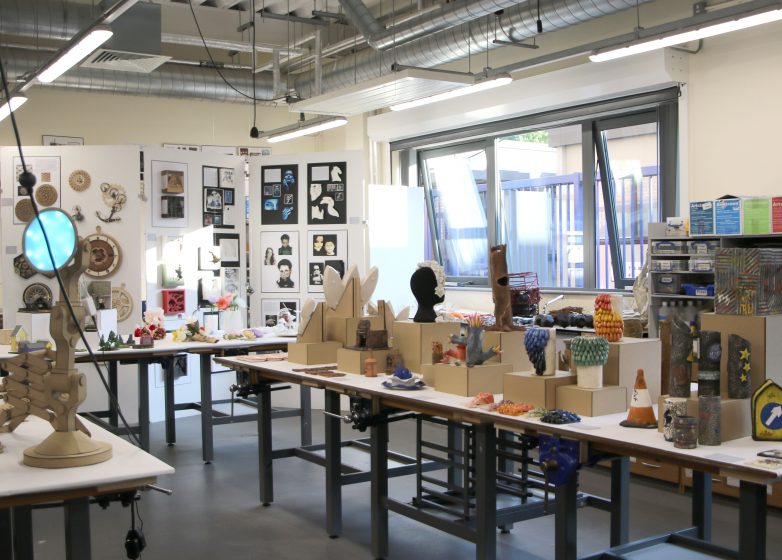Entry requirements
Click the button to read our faculty brochure or read more about the course below:
- Six GCSEs 9-4 (or A*-C)
- Two from English, Maths OR Science
- Two at least grade 6
Course specific requirements:
GCSE Art, Design Tech or Product Design at grade 9-4
OR portfolio of work if no GCSE Art
OR BTEC First at D/M with a portfolio of work
For full guidance on the portfolio task: click here
Please send any enquiries to the subject email: [email protected]

A Level 3D Design
- Want to be on the cutting edge of design in a tech-driven world?
- Dream of shaping immersive and interactive spaces?
- Looking to bring your artistic vision to life in three dimensions?
A Level 3D Design is a two-year art based course which allows you to be creative and expressive with their ideas and designs in both a 2dimensional and 3dimensional form. Projects are devised to help you understand the fundamental process of design through research, design development and final outcomes. You will be encouraged through experimentation with materials such as wood, wire, paper and clay and learning a wide range of techniques.
Exam board: OCR
Components
Component 1: personal investigation
You will produce two elements:
- A portfolio of practical work showing your personal response to either a starting point, brief, scenario or stimulus.
- A related study: an extended response of a guided minimum of 1000 words.
Percentage of total mark: 60%
Component 2: externally set assignment
Percentage of total mark: 40%
Skills
3D Design gives you a wide range of transferable skills which will support you in Higher Education and the workplace. 3D Design allows you the opportunity to use equipment and materials found in industry to help you prepare for your future career.
Careers/destinations
- Achitecture: Commercial, Industrial, Landscape and Residential
- Engineering: Architectural, Automotive, Civil, Industrial, Manufacturing,
- Mechanical, Mechatronics, Robotics and Structural
- Design: Animator, Automotive, Ceramic, Exhibition, Furniture, Jewellery,
- Industrial, Interior, Product, Prop Maker, Set Design, Theatre Design
3D Design
What GCSE subjects do I need to study 3D Design?
If you have studied Art, Design Technology, Product Design, Graphics or any other art-based subject then you would need to have gained a grade 5 or above.
Can I study 3D Design if I haven’t got a GCSE in an artbased subject?
Yes, that is possible, but we would like to see a portfolio of your work. This can be paper models that you have made from watching a YouTube clip or it could be sketches that you have done at home. You would then need to bring them with you when you come to enrol.
If I study the 3D design what could I then go on to study at University?
After studying 3D Design at Loreto, students go on to study the following courses: Architecture, Product Design, Engineering, Interior Design, Animation, 3D Design, Transport Design, Furniture Design, Jewellery Design, Set Design, Industrial Design or Ceramics.
Is the course an A Level?
Yes, the course is studied over two years alongside two other A Level courses. It is 100% coursework. You will have to sit a 15-hour exam at the end of your second year, but this is a practical exam.
What do you do on the course?
In Lower sixth, you will spend the first 14 weeks working with a wide range of materials and techniques such as paper, cardboard, clay, porcelain, wood and be taught how to use a range of CAD packages to allow work to be produced on the laser cutter and 3D Printer. You will then begin your Personal Investigation, which is worth 60% of your total A Level mark. The final stage of the course is your Externally Set Assignment and worth 40% of your total A Level mark; it is a practical exam over a 15-hour period.
Personal Investigation 60%
This project is personal to you, as you can choose exactly what you want to specialise in and carry out an investigation. You will research and analyse the work of numerous artists, then experiment with a wide range of materials and techniques gathering primary and secondary research to aid you. Next, you will come up with design ideas and develop them in to possible final concepts. Finally, you will produce either one or a range of final outcomes linking the whole project together. You will also be required to complete a related study which can be in the form of a document or a blog consisting of 1000-3000 words.
Externally Set Assignment 40%
You will be given a choice of seven questions and will need to undertake and complete one of these. This is exactly the same as the Personal Investigation, but studied over a shorter period of time. You are not required to write a related study for this assignment but will sit a 15-hour exam at the end of the course where you will be making a final outcome
How many students are in a class?
Class sizes range from 16 – 20 students, this means that students have enough space in the class room to carry out all set tasks.
Does the course have an exam?
Yes, a practical exam, please refer to Externally Set Assignment.
What other subjects could I study alongside 3D design?
This all depends on your chosen future career. Students wishing to go into a career in architecture or engineering usually study 3D Design, Maths and Physics. Some students choose to study two art-based subjects. The choice is yours; you could choose subjects that you are good at and enjoy, or you could look at university websites to see what subjects they recommend for your chosen career.
Do you use CAD on the course?
Yes, we have invested in high quality equipment, including a Laser cutter and 3D printer. In order to use these machines, you will be taught how to use AutoCAD (used in industry), 2D Design Techsoft, Illustrator and Photoshop.

